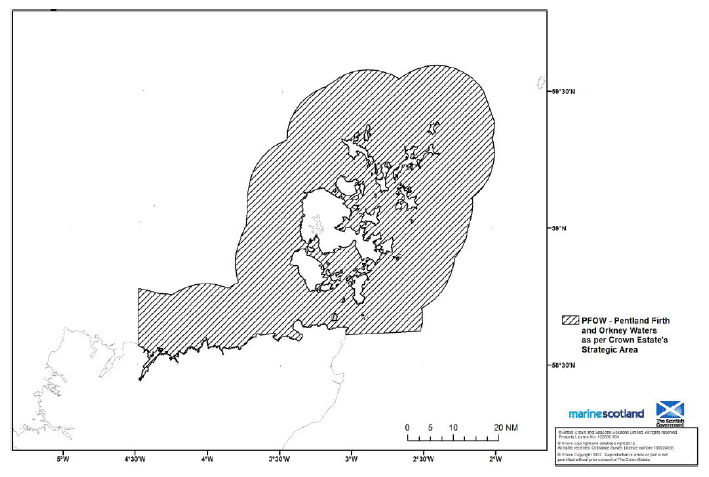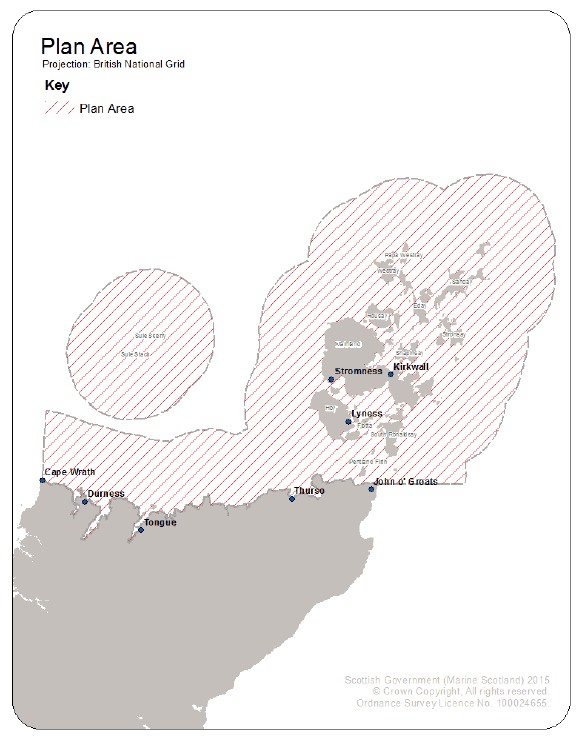Pilot Pentland Firth and Orkney Waters Marine Spatial Plan - Socio-Economic Baseline Review
This Socio-Economic Baseline Review provides a regional overview of the Pentland Firth and Orkney Waters area for the pilot Pentland Firth and Orkney Waters Marine Spatial Plan. It also informs the Sustainability Appraisal for this Plan.
2 PFOW Regional Overview
2.1 PFOW Geographical Coverage
2.1.1 Geographically, the pilot Pentland Firth and Orkney Waters Marine Spatial Plan ( PFOW MSP) framework covers the Pentland Firth and the waters around Orkney, from the mean high water mark out to the 12 nautical mile territorial limit. When the pilot marine spatial planning process for Pentland Firth and Orkney Waters commenced in 2009/10, the boundaries of the proposed Scottish Marine Regions had not been identified and the pilot Pentland Firth and Orkney Waters Marine Spatial Plan area (Figure 1) at this time was based on The Crown Estate strategic area for the Round 1 leasing of wave and tidal development.
Figure 1 Pentland Firth and Orkney Waters Marine Spatial Plan - Based on The Crown Estate's Strategic Area [2]

2.1.2 Now that the Scottish Marine Region boundaries have been identified the opportunity to align the pilot Marine Spatial Plan boundary with the proposed boundaries for the Orkney and North Coast marine regions can be considered. Realigning the boundaries for the plan assists with the successful migration of the pilot Marine Spatial Plan towards becoming a regional marine plan.
2.1.3 Figure 2 illustrates a proposed area for the pilot Marine Spatial Plan based on Scottish Marine Regions.
Figure 2 Pentland Firth and Orkney Waters Marine Spatial Plan - proposed area based on Scottish Marine Region [3]

2.2 Population
2.2.1 Census data show that in 2011 Orkney had a total population of 21,349. This was an increase of 10.9% from 2001, which is significantly above the population increases across the Highlands and Islands (7.5%) and Scotland (4.6%). In 2011, Caithness and Sutherland had a total population of 39,732. This was an increase of 3.3% from 2001, which was below the population increase across the Highlands and Islands and Scotland. Table 1 shows the population of Orkney and Caithness & Sutherland, along with the population of the Highlands and Islands and Scotland to put the figures in context.
Table 1 Total Population in PFOW area [4]
| Total Population | 2001 | 2011 | Percentage Change |
|---|---|---|---|
| Orkney | 19,245 | 21,349 | 10.9% |
| Caithness and Sutherland | 38,462 | 39,732 | 3.3% |
| Highlands and Islands | 433,524 | 466,112 | 7.5% |
| Scotland | 5,062,011 | 5,295,403 | 4.6% |
2.3 PFOW Area Economic Profile
2.3.1 The following section gives an overview of the PFOW socio-demographics. Data from the 2001 and 2011 Census have been utilised by Highlands and Islands Enterprise (2014) to produce area profiles for Orkney [5] and Caithness & Sutherland [6] . The findings from these area profiles are summarised to help to contextualise the socio-economic baseline review for the PFOW area.
2.3.2 The Nomenclature of Territorial Units for Statistics ( NUTS) is a hierarchical classification of administrative areas, used across the European Union for statistical purposes. The largest area classifications are NUTS1 and the smallest area classifications are NUTS3. Scotland is one of twelve NUTS1 areas in the UK. Highlands and Islands is the NUTS2 area relevant to the PFOW broken down into four NUTS3 areas; two of these areas are directly relevant to the PFOW:
- Caithness & Sutherland and Ross & Cromarty
- Orkney Islands
The Office for National Statistics provides NUTS3 level data for Gross Value Added ( GVA), shown in Table 2.
Table 2 Workplace based GVA at current basic prices [7]
| Workplace based GVA at current basic prices | £million | ||
|---|---|---|---|
| Region | 2011 | 2012 | 2013 |
| Scotland ( NUTS1) | 111,535 | 113,819 | 117,116 |
| Highlands and Islands ( NUTS2) | 8,340 | 8,211 | 8,469 |
| Caithness & Sutherland and Ross & Cromarty ( NUTS3) | 1,339 | 1,281 | 1,319 |
| Orkney Islands ( NUTS3) | 354 | 367 | 385 |
2.3.3 ONS also provide data on GVA per head, as shown in Table 3.
Table 3 Workplace based GVA at current basic prices [7]
| Workplace based GVA per head at current basic prices | GVA per head (£) | ||
|---|---|---|---|
| Region | 2011 | 2012 | 2013 |
| Scotland ( NUTS1) | 21,045 | 21,420 | 21,982 |
| Highlands and Islands ( NUTS2) | 17,856 | 17,616 | 18,123 |
| Caithness & Sutherland and Ross & Cromarty ( NUTS3) | 14,032 | 13,452 | 13,882 |
| Orkney Islands ( NUTS3) | 16,534 | 17,036 | 17,853 |
2.4 Employment
2.4.1 Official Labour market statistics show that between January and December 2014 13,000 people in the Orkney Islands local authority were economically active. This represented 91.7% of 16-64 year olds, and was above the Scotland rate of 77.5%. 124,800 were economically active in 2014 in the Highland local authority, comprising 81% of 16-64 year olds. 2014 Labour market data is not available for Caithness and Sutherland, however 2011 census data shows that some 68.3% of the Caithness and Sutherland population, aged 16 to 74, was economically active. This was below both the Highlands and Islands and Scotland rates of 71.3 % and 69.0 % respectively. [8]
2.4.2 Table 4 shows Highlands and Island Enterprise data on the number of active enterprises and business starts in the area surrounding PFOW.
Table 4 Total Employment, Active Enterprises and Business Starts, 2012 [9]
| Number | Per 10000 Adults | |||||
|---|---|---|---|---|---|---|
| Total Employment | Active Enterprises | Business Starts | Total Employment | Active Enterprises | Business Starts | |
| Orkney | 10,200 | 830 | 77 | 5,667 | 461 | 43 |
| Caithness & Sutherland | 15,300 | NA | NA | 4,799 | NA | NA |
| Highlands and Islands | 201,600 | 17,575 | 1,627 | 5,519 | 479 | 44 |
| Scotland | 2,425,900 | 158,320 | 13,856 | 5,540 | 362 | 32 |
2.4.3 Labour market profile data are also available at a local authority level for Highlands and Orkney Islands from the ONS website. [10] Table 5 shows Employee jobs by industry for Orkney. This data cannot be disaggregated for Highland but there is 2011 Census data for the nine Settlement Zones on the North Coast of the Highland local authority area and this has been aggregated as shown in Table 6. It should be noted that these figures do not include self-employment, including certain types of sea-fishing, and thus will understate total employment.
Table 5 Employee Jobs by Industry - Orkney Islands (2013) [11]
| Industry | Number | Percentage | Scotland (%) |
|---|---|---|---|
| Total Employee Jobs | 9400 | 100% | 100% |
| Primary Services (A-B: agriculture and mining) | 400 | 4.0% | 1.7% |
| Energy and Water (D-E) | 100 | 0.6% | 1.4% |
| Manufacturing (C) | 400 | 3.8% | 7.4% |
| Construction (F) | 800 | 8.9% | 5.5% |
| Services (G-S) | 7800 | 82.8% | 84.0% |
| Wholesale and retail, including motor trades (G) | 1200 | 13.2% | 14.7% |
| Transport storage (H) | 700 | 7.7% | 4.0% |
| Accommodation and food services(I) | 1000 | 10.5% | 7.8% |
| Information and communication (J) | 100 | 1.2% | 2.7% |
| Financial and other business services(K-N) | 1000 | 10.4% | 19.6% |
| Public admin, education and health (O-Q) | 3300 | 35.3% | 30.4% |
| Other Services (R-S) | 400 | 4.6% | 4.8% |
Table 6 Employee Jobs by Industry - PFOW 'Highland North Coast' (2011) [12]
| Industry | Number | Percentage | Scotland (%) |
|---|---|---|---|
| Total Employee Jobs | 6977 | 100% | 100% |
| Primary Services (A-B: agriculture and mining) | 458 | 6.8% | 3.4% |
| Energy and Water (D-E) | 484 | 7.1% | 1.6% |
| Manufacturing (C) | 397 | 5.8% | 7.7% |
| Construction (F) | 597 | 8.8% | 8.0% |
| Services (G-S) | 4862 | 71.5% | 79.5% |
| Wholesale and retail, including motor trades (G) | 817 | 12.0% | 15.0% |
| Transport storage (H) | 301 | 4.4% | 5.0% |
| Accommodation and food services(I) | 470 | 6.9% | 6.3% |
| Information and communication (J) | 228 | 3.4% | 2.7% |
| Financial and other business services(K-N) | 932 | 13.7% | 15.2% |
| Public admin, education and health (O-Q) | 1875 | 27.6% | 30.4% |
| Other Services (R-S) | 239 | 3.5% | 4.9% |
2.4.4 Further information on labour market supply figures such as economic activity for Highland and Orkney Islands can be found on the ONS website.
Contact
There is a problem
Thanks for your feedback